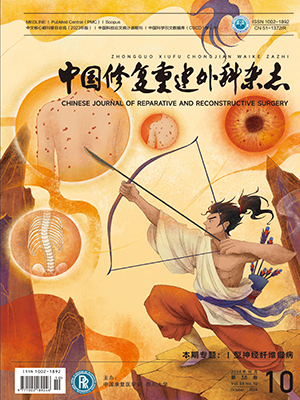| 1. |
Xu Y, Sun Y, Shi R, et al. A clinical comparative study on percutaneous and open approaches for screw internal fixation in treating thoracolumbar fractures. Orthop Surg, 2023, 15(10): 2532-2539.
|
| 2. |
Huang J, Zhou L, Yan Z, et al. Effect of manual reduction and indirect decompression on thoracolumbar burst fracture: a comparison study. J Orthop Surg Res, 2020, 15(1): 532.
|
| 3. |
Shin SR, Lee SS, Kim JH, et al. Thoracolumbar burst fractures in patients with neurological deficit: Anterior approach versus posterior percutaneous fixation with laminotomy. J Clin Neurosci, 2020, 75: 11-18.
|
| 4. |
李雷, 郭洋, 高建, 等. 经皮椎弓根钉内固定分别联合同切口通道减压术、后路常规减压术治疗伴有神经损伤的胸腰椎爆裂性骨折疗效对比. 颈腰痛杂志, 2023, 44(4): 660-662.
|
| 5. |
Li X, Guan Z, Chen X, et al. Modified minimally invasive technique for decompression and reduction of thoracolumbar burst fracture with neurological symptoms: Technical note. J Orthop Surg Res, 2021, 16(1): 626.
|
| 6. |
祝乃强, 侯静怡, 马桂云, 等. 经皮椎弓根螺钉联合椎间孔镜治疗伴有神经功能损害的腰椎爆裂骨折的疗效观察. 河北医学, 2018, 24(10): 1736-1739.
|
| 7. |
Chang H, Xu J, Yang D, et al. Comparison of full-endoscopic foraminoplasty and lumbar discectomy (FEFLD), unilateral biportal endoscopic (UBE) discectomy, and microdiscectomy (MD) for symptomatic lumbar disc herniation. Eur Spine J, 2023, 32(2): 542-554.
|
| 8. |
康辉, 徐峰, 熊承杰, 等. 单平面钉经皮伤椎短节段固定治疗胸腰椎骨折. 中国修复重建外科杂志, 2020, 34(3): 308-312.
|
| 9. |
Hughes H, Carthy AM, Sheridan GA, et al. Thoracolumbar burst fractures: a systematic review and meta-analysis comparing posterior-only instrumentation versus combined anterior-posterior instrumentation. Spine (Phila Pa 1976), 2021, 46(15): E840-E849.
|
| 10. |
Trungu S, Ricciardi L, Forcato S, et al. Percutaneous pedicle screw fixation without arthrodesis of 368 thoracolumbar fractures: long-term clinical and radiological outcomes in a single institution. Eur Spine J, 2023, 32(1): 75-83.
|
| 11. |
张世磊, 丁子毅, 高扬. 微创经皮单平面椎弓根螺钉与传统内固定系统治疗胸腰椎压缩骨折的疗效比较. 武汉大学学报(医学版), 2021, 42(2): 307-311.
|
| 12. |
林振, 彭柏华, 郑力恒, 等. 单侧双通道内镜技术治疗神经根型颈椎病的早期临床疗效. 中国脊柱脊髓杂志, 2022, 32(7): 668-672.
|
| 13. |
Chu PL, Wang T, Zheng JL, et al. Global and current research trends of unilateral biportal endoscopy/biportal endoscopic spinal surgery in the treatment of lumbar degenerative diseases: a bibliometric and visualization study. Orthop Surg, 2022, 14(4): 635-643.
|
| 14. |
Laghmouche N, Prost S, Farah K, et al. Minimally invasive treatment of thoracolumbar flexion-distraction fracture. Orthop Traumatol Surg Res, 2019, 105(2): 347-350.
|
| 15. |
Wang XB, Lü GH, Li J, et al. Posterior distraction and instrumentation cannot always reduce displaced and rotated posterosuperior fracture fragments in thoracolumbar burst fracture. Clin Spine Surg, 2017, 30(3): E317-E322.
|
| 16. |
Lofrese G, Visani J, Cultrera F, et al. Anterior dural tear in thoracic and lumbar spinal fractures: single-center experience with coating technique and literature review of the available strategies. Life (Basel), 2021, 11(9): 875.
|




